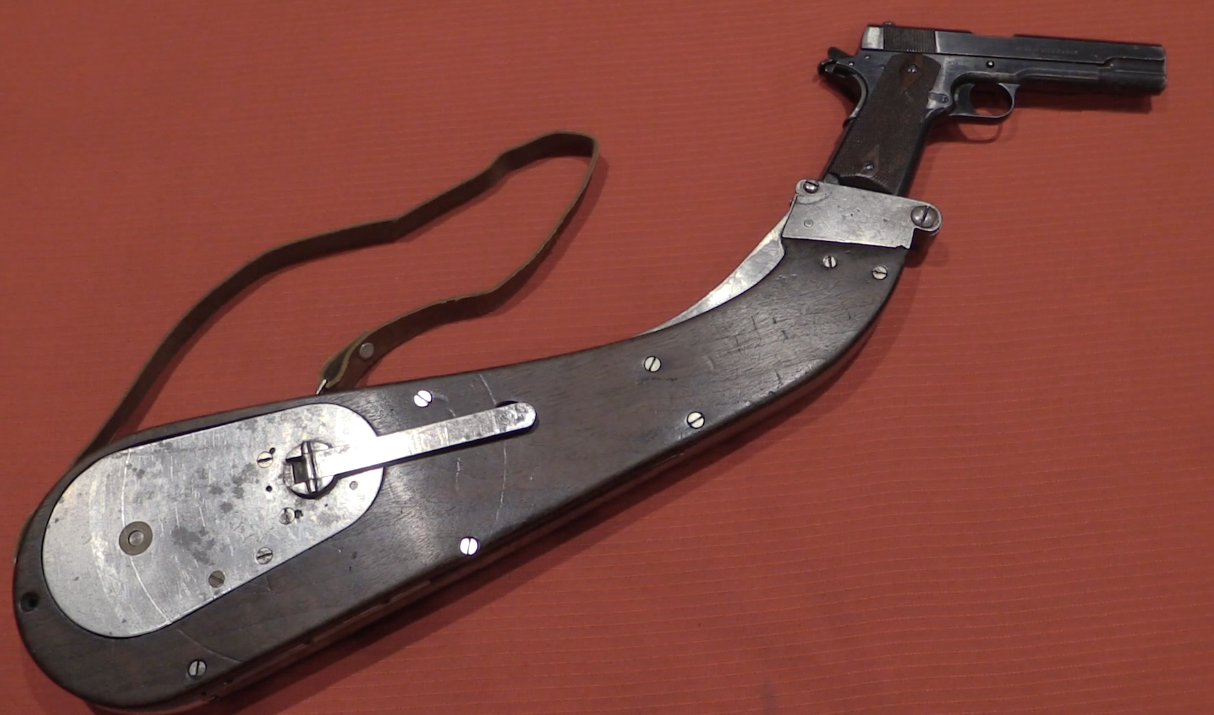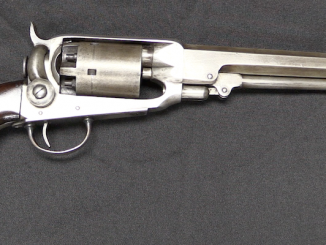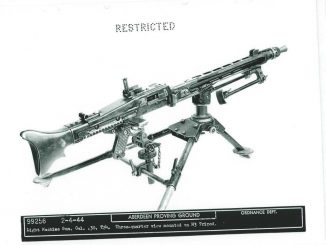In the mid 1950s, the Winchester company designed a compact 9mm submachine gun for military use. It was internally called the. “NATO Burp Gun”, and according to Winchester historian Herbert House, was developed in part (or with the assistance of) Melvin Johnson. The design was a simple tubular receiver with a folding stock that doubled as a vertical front grip when folded. Instead of an external charging handle, it used serrations cur in the side of the bolt, making the gun sleek and compact (albeit more difficult to cock). Today we are looking at the N2 and M4 developmental patterns, both housed at the Cody Firearms Museum. The development program got little further than these prototypes before Winchester abandoned it.
Thanks to the Cody Firearms Museum for allowing me access to film these very interesting prototypes!




Charging the action looks like a way to get blisters.
Ian you have minor typo in the 4th sentence. Cur instead of cut.
Keep up the great work!
You can delete this e-mail.
Oh contraire. Ian is merely being dogged in his work.
The Cody museum content reminded me, have you every done any work at the Kentucky Military History Museum? They host the General George M. Chinn collection. He seems a kindred soul. My daughter and I stopped on the way to a pistol match a couple of years ago, you don’t often get to see a barracks rack of 1903 Springfields and 1911s on display.
It looks like an attempt at synthesis from MP40, Samopal and UZI.
It is completely unclear exactly, what problems they tried to solve on Winchester by experimenting with this hybrid.
It looks expensive to manufacture and non-functional to use.
Right, some kind of garage amateur performance…
A real burp.
I agree completely, no special innovation whatsoever
The look very “Bladerunner” to me. The stock folding / forward handgrip arrangement looks good. No sights on these prototypes, it seems.
Its goofy, nobody would hold it that far, close to the muzzle
I can see why Winchester would have dropped this project. Apart from the fact that guns like the Sterling were better, the US Army at the time seemed to think the M14 would replace everything from the pistol to the BAR, so no requirement for an SMG there.
I don’t think the US really ever “got” the point of the entire weapons class, to be honest. Just like the GPMG, the whole thing was foreign to American thought, which revolves around the myth of the Kentucky long rifle winning the Revolutionary War.
Which is why you don’t have any examples of a really good American-made SMG. No supporting mental infrastructure–The SMG is something those evil bad guys use, burp-gunning their way through the night and darkness.
Hell, the only truly worthwhile SMG ever produced on US shores was a copy of the Swedish Carl Gustav… What does that tell you?
Well, the “Tommy Gun” was one of the earliest SMG’s and most widely used. It’s certainly “worthwhile”, likely quite a bit more.
The Thompson was too heavy, unwieldy, and represented a design dead-end. Show me where it was at all influential, in terms of being copied and used by other nations–You can’t. The only reason it saw widespread issue was the whole “Not invented here…” syndrome, and the fact that it was the only game in town for far too long.
The US could have fielded an effective SMG or even a full-auto M1 Carbine before and during WWII. It did not, and the reason was that they did not really see the use of such a thing.
The Thompson, the M3, and the M1 Carbine represent auxiliary weapons that fit more into the PDW class than the way the Germans, Soviets, and even the Brits used the SMG. This was purely due to the American predilection for the vaunted “individual rifleman”, a chimerical mirage if there ever was one.
It’s why we built the M1 Garand, and then constructed our entire tactical doctrine around it, mostly in the delusional pursuit of the ideas coming out of the Revolutionary War, the NRA, and the gravel-bellies running the National Matches. None of which really got tactical validation, when you get right down to it–The lack of belt-fed fire support had to wait until they got the M1919A6 into widespread issue before we were really on a path towards recognizing reality, which didn’t happen until sometime in the 1960s after encountering the Soviet tactical system and the weapons that they designed to support that in Vietnam.
The reality is that the US has done a really abysmal job at assessing what went on in combat, and then equipping its forces with weapons and doctrine to suit reality. Hell, it’s going on today, even as we speak–The various idjits are hell-bent on recapitulating the entire process that produced the 7.62mm/M14 combo as an individual weapon, despite copious evidence that it’s entirely unnecessary and soluble by other means. In all likelihood, we’re going to wind up with another failed “neither fish nor fowl” solution out in the ranks, and it’s going to lead to dead GIs again.
Reality is, the two-caliber solution works.
Kirk:
I hear you.
It was greatly to the credit of the USA that they fielded the M1 rifle during WWII. The Thompson gun, on the other hand, was a beast. It weighed more than the rifle!
The British had been extremely negligent over the development of SMGs before the war, but even they managed to put the Sten together in a few months.
Really, the Thompson should not have been built in the numbers it was. There was no need for 11 lbs of machined steel to make an SMG. Every other country dropped these expensive pre-war designs very quickly. Only the wealth and industrial capacity of the USA meant they could turn out over a million Tommy guns.
To make the Thompson really cost-effective from the start, the changes needed would have been;
1. Make the upper and lower receiver assemblies from aircraft-grade aluminum rather than steel. This would have cut the weight by about a fourth.
2. Chamber it for .351 WSL instead of .45 ACP. An actual rifle cartridge instead of a pistol round with subsonic muzzle velocity.
3. Once the French developed their 8mm cartridge based on the .351 WSL, adopt it or a .30 version in the gun.
Surprise. The “assault rifle” arrives in the 1920s instead of 1942.
cheers
eon
“1. Make the upper and lower receiver assemblies from aircraft-grade aluminum rather than steel. This would have cut the weight by about a fourth.(…)”
I do not know what “upper” and “lower receiver” is in case of M1 sub-machine gun as manual does not support this, but if you meant RECEIVER or FRAME GROUP as shown in Fig. 10 http://www.nfatoys.com/tsmg/web/m1assy.htm
then aluminum Thompson was made, albeit in 1940 not 1920s, see: http://www.smallarmsreview.com/display.article.cfm?idarticles=1971
It was made by Savage Arms starting in 1940, it was version of 1928 Thompson which used heat treated aluminum forgings which lighter and due to properties of alloy used it was faster to made. Additionally furniture was made from Tenite instead of walnut, making it further lighter.
Numerous problem appeared, Savage engineers were not able to solve or at least ameliorate all to such extent that it would be able to pass 20000 round test.
“(…)Show me where it was at all influential, in terms of being copied and used by other nations–You can’t.(…)”
I would say Australian OWEN MACHINE CARBINE show some influence from Thompson.
You might select fire of mode using thumb with hand on grip.
“US could have fielded an effective SMG or even a full-auto M1 Carbine before and during WWII”
Original requirements https://www.forgottenweapons.com/light-rifle-program/ stipulated The primary requirements for the rifle were a weight of not more than 5 pounds (with sling), effective range of 300 yards, and capability for both semiauto and fully automatic fire. The rifles had to use the .30 Carbine cartridge
The Thompson was used, and produced early in WWII, because it was available. Early in WWII work was started on replacements, resulting in the perfectly competent M3 Grease Gun. Which was used up into the 1990’s by the US Army. And Ian had a fascinating video on the M2.
There is something odd about damning the US military for not putting more work into SMGs, when no one really seems to be using them anymore, having mainly gone to cut down rifles, often the one that the US Military adopted 50 years ago.
In WW2 and during the Cold War SMGs were in widespread issue and certainly had their high times in WW2 and Korea. Also in all those littel wars in the fifties and sixties during decolonization. And also into the first half of the vietnam War SMGs were saght after. Only the beginning introduciton of the M16 and AK(M) moved the SMG to the side. But still you can find SMGs issued to one or two soldiers in a troop. Especially when G3 or FAL were still issued. Also for vehicle crews the Bundeswehr and many other armies still issue Uzis for example. so no, the SMG is far from dead and imho is superior for room clearing in a house for police work, because with a short 5,56 mm blaster you blast eardrums out and hinder communication and throw flames out the muzzle. Yes in military context the compromise is nowadaysvery often made to just use a short carbine. So yes, the SMG has reduced usefulness in an age of compact lightweight rifles, but still has a few advantages and so can be found in niches.
“In WW2 and during the Cold War SMGs were in widespread issue and certainly had their high times in WW2 and Korea.(…)”
Yes – firing 9×19 mm cartridge. .45 Auto, due to high mass and low muzzle velocity is lesser suited for use in sub-machine gun. Due to first number of cartridge carried is smaller, due to latter error in distance judgements have greater consequences.
“(…)only truly worthwhile SMG ever produced on US shores was a copy of the Swedish Carl Gustav(…)”
Wait… what about UD M42
https://modernfirearms.net/en/submachine-guns/u-s-a-submachine-guns/ud-m42-eng/
?
Another magic gun which was supposed to beat commies. It had to be put away till Gorbie came along 🙂
If they has become a thing, we would have seen them being used without stock in cheesy 80s movies.
This “NATO Burp Gun” external appearance reminded me some another sub-machine gun, but I need some time to find which one exactly.
It was weapon made by Madsen of Denmark, which http://firearms.96.lt/ identify as P16, see SUBMACHINE GUNS section Denmark.
Drawing of weapon with stock folded can be seen here: https://www.the-blueprints.com/blueprints/weapons/weapons/88564/view/madsen_m1945_smg/
Note that part of stock is sticking downward, so it probably might serve as grip, but I do not know if it was supposed usage or if it would be comfortable.
SMGs without protruding cocking handles on the bolt:
USA: M3A1 .45 Grease gun (slot for finger)
Austria: Arguably, the earliest MPi69 Uzi-copy, which used the carrying strap to cock the bolt, perhaps a bit redolent of Italian self-loading rifle prototypes from the 1930s?
Danish Madsen 1945 (some sold to El Salvador, perhaps other Latin American “end users”) Earliest M/50 with the charging lever flush with the top, before replaced by more conventional lug/charging knob. Brazilian .45 acp INA53 version used conventional bolt handle.
France: MAC-47 prototype, used a lever under the trigger guard a bit like the original M2 Grease Gun non-reciprocating bolt charging lever.
Italian Brescia FNAB prototypes use an external “slide” a bit like this, but roomier for the fingers, I think?
UK–the SOE “Welgun” prototype. The MCEM prototypes.The BSA SMG prototypes.
Mexican Mendoza uses slide-type grip on telescoping/overhanging bolt.
Polish PM-63 uses external “slide” type bolt… Any others?
“SMGs without protruding cocking handles on the bolt(…)Any others?”
Nambu model I https://modernfirearms.net/en/submachine-guns/japan-submachine-guns/nambu-model-1-eng/
In deference to Kirk’s input, I have to say this as a bad joke: The only reason America got away with the M1 Garand and the whole “riflemen kill everything” idea was that America was NEVER INVADED OR OCCUPIED during WW1. After all, if we want to stress keeping invaders out at little cost to ourselves, do we throw hordes of riflemen against the invaders, or do we train more machine gunners? And if the invaders get past our lines and occupy entire counties (and take the civilian populations hostage), how do you respond to such antics? You wouldn’t DARE bombard your own cities with the artillery, right? I could be wrong.
Again the buffalo skins climbed …
You, at least, approximately familiarized yourself with the question. Before writing such nonsense.
First there was the Pedersen device. Which was developed to smooth out the lack of its own LMG and SMG. They were late.
Then there was Thompson’s SMG. Which SMG became by accident, to make up for the lack of military orders in peacetime. In general, this is an automatic carbine, under a powerful enough matrons. Which arose out of some work on the topic of self-loading rifles.
Possibly to recover some of the rifle development costs.
And when it was diminished for a pistol cartridge, it turned out to be quite good as an SMG.
Expensive it is. But no one expected that they would have to supply half the globe with them.
And to argue that Thompson is an unsuccessful sample can only be a sofa troll, who has seen the device only on the Internet.
And when it turned out that “more Tommy is needed!”, They came up with Greaser.
The sample is as ugly in appearance as it is comfortable and deadly effective in service.
Yes, there were some tricky places with magazines, but for a competent user, this was not a problem.
At the same time, this time, everything was OK with the price.
There were also less well-known things that did not receive such wide recognition, but they were quite perfect.
And then SMGs were simply not needed. Especially with the advent of 223.
Why develop these SMGs at Winchester, when there already were the STEN and M3 SMGs as cheap guns? A Sterling does not seem to be really more expensive than these designs either and there were lots of other designs around of good, reliable & cheap SMGs. The Uzi had the economies of scale on its side.
Sooo, for whom was this Winchester project intended after all?
Good questions! That it was built around the MP-40 magazine is either because a) these were cheap and available, or b) because the magazine was considered something that could be utilized, since there were still so many in circulation? Again, all speculative.
Certainly Winchester also developed the so-called Liberator four-barrel box-lock shotgun prototype as a projectile launcher for technologically backwards or unsophisticated peoples as a “point and shoot” type of cheap weapon. A Peruvian/ Ingram design effort resulted in a cheap Sten Mk.II copy intended to arm Cuban counterrevolutionaries after the CIA had largely turned the taps after the October ’62 Missile Crisis and the the LBJ focus on Vietnam…
There were any number of WWII weapons repurposed for the various caches for the “Gladio” stay behind forces within Nato members… One wonders.
As Ian noted, in a world awash with WWII surplus burp guns, and only a handful of designs postwar becoming successful, e.g. the Israeli/ FN Uzi, the Sten gun perfected in the kp m/45, arguably the Beretta M12, MAT-49 for Francophone use, Sterling for Anglophone use, why bother with a fairly anodyne or even boring open-bolt tube-receiver SMG at all?
“(…)for whom was this Winchester project intended after all?”
I suspect it went as follows: someone at Winchester responsible for direction of developments got report which concluded that NATO member states (back when it was primal dozen) would be interested in brand new design of 9×19 mm folding-stock sub-machine gun. So development was started. But some time later it was realized that whilst many of them already do have such need they do prefer own designs (France MAT-49) or buy know-how/license from neutral (Denmark Hovea 1949), which resulted in dropping of this development.
A little correction: Denmark joined the NATO in 1949 as part of the early twelwe members, so the Hovea 1949 was not a design from a neutral country.
“(…)Hovea 1949 was not a design from a neutral country.”
It was made in Denmark, but designed in Sweden
https://modernfirearms.net/en/submachine-guns/denmark-submachine-guns/hovea-m49-eng/
The Hovea was not exactly a “big seller” in SMG sales…
Carl Gustaf m/45: Sweden, Eire/Ireland, Egyptian license-built versions “Port Said” and “Akaba,” U.S. special forces, ARVN/ S. Vietnam (limited), from there it proliferated a bit. The Chilean left wing guerrilla movement MIR made plans to produce the m/45 in factories and workshops, but in the end, the Chilean armed forces let loose by Augusto Pinochet smashed them along with much else besides.
The Hovea M/49 was used only by tiny Denmark, and then not in appreciable numbers.
The big post-WWII SMG success stories would have to include the Israeli/Belgian Uzi (resulting in many copies elsewhere), the HK MP5 9mm select-fire rifle/SMG–particularly among police and paramilitaries, the MAT-49 in Francophone ex-colonies, the Sterling in Anglophone ex-colonies, Dominions, and Commonwealth nations, and not much else. Plenty of ex-WWII era guns remained in use of course.